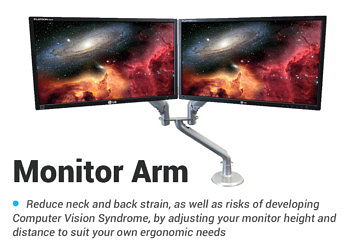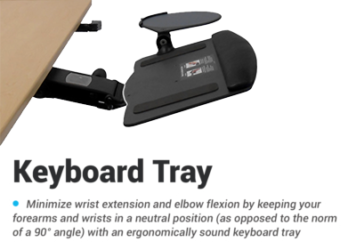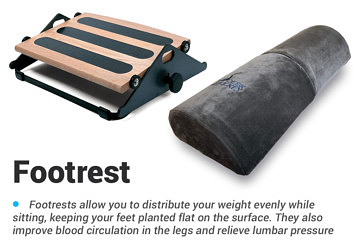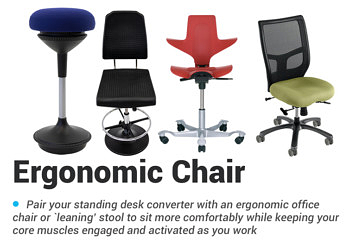The Best Manual Standing Desks
Like most reviews sites, our editorial staff and laboratory testing expenses are partially offset by earning small commissions (at no cost to you) when you purchase something through those links. Learn More

Is a Manual Standing Desk Right for You?
If you’re in the market for an adjustable-height desk but don’t want one of the many electric models that dominate the market, there are still options out there.
It might be because you don’t have easy access to an outlet where you put your desk, you need your desk to be able to be more mobile than standard workstations, or you just want to not add any more to an already exploding power bill. All of these reasons and more are valid motives to opt for an adjustable-height desk that you lift and lower manually, though with a variety of mechanisms.
Manual Standing Desk Product Categories
Each of our manual desk reviews fall under one of three categories.
- Higher Tech bases without electronics use methods such as counterbalance, spring-loaded, and gas-strut mechanisms and offer quick and easy movement.
- Crank-adjustable stand desks used to be the most popular adjustable mechanisms, and are generally more affordable than their motorized counterparts, though harder to find these days.
- One-time adjustable standing desks, which often misleadingly tout themselves as “manually-adjustable,” are always crawling out of the woodwork but rarely a good solution for a sit-stand or treadmill desk.
Below, you’ll find abstracts of each product review by category.
Counterbalance, Spring-Loaded and Gas Strut Standing Desks
Anyone on the hunt for a fast-moving, high-end workstation could find themselves checking out counterbalance options. A select group of high-end manufacturers have begun to make desks that glide up and down, requiring nothing more than the squeeze of a brake and some minimal help from the user. These desks use a non-electric counterbalance system that offsets the weight of the things on your desk. That’s the theory, anyway—some take a little more muscle than advertised. Be forewarned they are often even more expensive than electrics, and even the most expensive models will have lower lift ratings than comparable crank desks. Additionally, it is not uncommon for these desks to be somewhat finicky in their tension settings.
When they’re well-adjusted, these systems are sleek, impressive, and incredibly quick to adjust: the quickest height adjustment speeds, in fact. They do lack the presets of an electric option, but frankly, who needs them when you can express it to the perfect height in two seconds?
1. The Standing Desk Kloud Height-Adjustable Workstation
If a pneumatic standing desk is ideal for your work environment, we have yet to see any that measure up to the level as those from The Standing Desk, and the Kloud is perfect for those that need more than just a place to put their laptop. With the net lifting capacity of 90 lbs (150 lbs of max counterbalance minus the 60lb desktop) you’ll have plenty of load capacity even without having to be plugged into a power outlet. With quick and smooth movement between sitting and standing heights, you can find your next working position in a fraction of the time it takes an electric lifting base to move, and with whisper-quiet operation. You won’t get some of the possible conveniences of electric height-adjustable desks, like saved heights, standing reminders, and more, but pneumatics might fit your working situation much more, especially if your desk needs to be more mobilized on caster wheels. Compared to other premium grade standing desks, the only real downside to the Kloud is the desktop, which is the standard HPL as is used on many cheaper desks, without any ergo contouring and only 5 color options. But if you want a non-electric standing desk that still has the size and power for a normal workstation, the Kloud is the way to go.
Price: $999
2. Humanscale Float Table
There’s something almost seductive about a Float table. Innovative counterbalance technology makes these desks fast, easy adjusters.
Price: $1,635
Crank-Adjustable Standing Desks
Manual adjustment desks rely on a user-operated crank mechanism, generally located in a corner either under or on top of the desktop, though on some older models, the crank can be found in odd places like on the side of one of the lifting columns or on top of the table. Most crank desks move at a rate of two to six turns per inch, and adjusting from sitting to standing or walking generally takes under half a minute. Crank-adjustable desks are especially popular in shared treadmill desk workstations, which don’t need to adjust all the way down to sitting height.
Many might even consider the cranking process as a healthy exercising break from work that you can take throughout the day.
There are some older crank desks on the market with a very short height adjustment range (“stroke”) of about 14″. These models can be shared between people of different heights, but not used as a sitting desk. Ironically, they are typically more expensive and have slower cranks than the more updated models we review here.
1. Focal Locus Workstation
An ergonomist’s dream realized by a craftsman. Focal owe themselves a pat on the back – the Locus really is an impressive piece of work. We’ve seen leaning chairs before, but most follow a somewhat Spartan mold. Not so with the Locus; the pairing of desk and chair makes this the first integrated leaning workstation we’ve tested. Well-designed, well-built, and supported by a friendly, dedicated company – the Locus should be the first port of call for anyone interested in a leaning workday.
Price: $ 1,106
2. MultiTable ModTable
The ModTable desk was once the king of low-cost stand up desk. Its quick-adjusting crank mechanism is simple to use and wasn’t tethered to a power outlet the way motorized desks are. But changes in the stand up desk marketplace have resulted in cheaper, more powerful electric desks, and ModTable has since lost its main advantage over other desk options.
Price: $515
3. Luxor Crank Adjustable Desk
The budget-class Luxor stand up desk’s height adjustment, speed, and ergonomic profile leave much to be desired, and its unique crank placement creates its own problems. While some users may like its affordability and warranty, the Luxor looks ancient and ill-equipped to provide a satisfactory ergonomic workstation.
Price: $ 337
One-Time Adjustable Standing Desks
Calling these clunkers ‘manually-adjustable’ is a quite a stretch—users set the height of these desks with locking pins in the telescoping legs. After the initial set-up, these fixed-height desks can’t easily be adjusted to different heights. Users would need to clear the desktop of their equipment and remove or loosen the locking pins to change the height, with the help of a friend, if not two. It’s an exceedingly tedious process not recommended for multiple-user workstations.
For all intents and purposes, these desks should be considered fixed-height standing desks. Desks in this category aren’t all that much cheaper than most actual manual desks, either. The fixed-height desk that comes with LifeSpan Fitness’s DT5 treadmill desks cost an additional $500 on top of the treadmill. For slightly more money, you can get a number of true adjustable-height desks, and they’ll come in a lot more sizes, and nicer colors than “gymnasium gray.”
1. LifeSpan Fitness DT5
Lifespan’s entry into the treadmill desk market is literally the event that led us to start developing this reviews and advice website back in 2012. As the first commercially-produced treadmill desk offering reasonably priced, reasonable quality alternatives to the first treadmill desk (a severely overpriced one from Steelcase), we know that many thousands of our readers over the years started their foray into treadmill desking with a Lifespan Fitness TR800, TR1200 or TR5000 under their feet. The pandemic has taken many victims in the business world, too, and we’re sad to report that the once-great Lifespan Fitness product appear to have contracted a bad case of “long Covid.” The company is now wholly owned and operated by its former exclusive manufacturing partner in Taiwan, with not even a phone number for retail customers to call in the United States. Prices have been dramatically increased while the treadmill products have had their warranties completely eliminated as a “shrinkflation” tactic to maintain profit margins. (Prepare to include one of their “extended” warranty plans in your purchase price, starting at $270, if you still choose to take a chance on the company.) Specs, photography and other outward indications reveal the company’s complete lack of understanding of the ergonomics of working at a walking workstation, leading customers to set up potentially injurious desk configurations. Not surprisingly, the company’s website traffic and market share is dwindling quickly as the American senior management team that ran the company for 19 years have walked out the door, taking their deep institutional knowledge with them. We’ve had to rescind our buy recommendations across the board on the Lifespan products as for the prices Lifespan they now charge you could step up to a much higher-quality product, with a solid warranty, much higher longevity, far more extensive desk size and color options, and first-rate American engineering and customer support.
Price: $1,449
2. TrekDesk
Overhyped by a manufacturer with very questionable marketing practices, the TrekDesk has the fundamental problem of violating many of the basic rules of how to build an ergonomically-proper, stable, attractive and productive treadmill desk. We would caution anyone thinking of buying a TrekDesk to research it carefully, and then search Craigslist for used units. For $70 more you could purchase an adjustable-height desk and be ten times happier.
Price: $649.99
3. Go Treadmill Desk
The Go Treadmill Desk, designed to fit over a running treadmill, doesn’t inspire much confidence. Its spindly legs and lightweight frame won’t be as stable as the heavier, solid desks that we recommend. Its design does not lend itself to proper ergonomic posture, so wrist and neck pain and reduced productivity are likely to be a concern.
Looking For More Standing Desk Reviews?
• Quick Install Standing Desks






2 Comments
Leave a response >